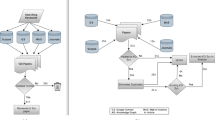Abstract
This article presents a relations taxonomy constructed on the basis of a conceptual framework, as well as methods of identifying semantic relations that are used for automatically constructing ontologies of subject areas. A predicate lexicon that corresponds to relation types is established through automatically processing a collection of scientific and technical document texts. Patterns of linguistic constructions of semantic relations are constructed in a way that considers morphological features of words and morphemes. Statistics of types of relations and the use of patterns depending on the document type are studied.
Similar content being viewed by others
References
Van Renssen, A., Gellish: A Generic Extensible Ontological Language, Delft: Delft University Press, 2005.
SINTOL, in Sbornik perevodov po voprosam informatsionnoi teorii i praktiki (Collection of Translations on Information Theory and Practice), Moscow: Vses. Inst. Nauchn. Tekh. Inf., 1968, pp. 36–47, 50–52, 66–72, 76–80.
Skorokhod’ko, E.F., Linguistic problems of processing theists in automated information retrieval systems, Vopr. Inf. Teor. Prakt., 1974, no.25, pp. 5–120.
Winograd, T., Understanding Natural Language, Academic Press, 1976.
Maksimov, N.V., The methodological basis of ontological documentary information modeling, Autom. Doc. Math. Linguist., 2018 vol. 52, no.3, pp. 57–72.
Golitsyna, O.L., Maksimov, N.V., Okropishina, O.V., and Strogonov, V.I., The ontological approach to the identification of information in tasks of document retrieval, Autom. Doc. Math. Linguist., 2012, vol. 46, no. 3, pp. 125–132.
Gordei, A.N., The theory of automatic generation of the knowledge architecture (TAPAZ-2) and further minimization of semantic calculi, in Otkrytye semanticheskie tekhnologii proektirovaniya intellektual’nykh sistem. Materialy IV Mezhdunar. nauch.-tekhn. konf. (Minsk, 20–22 fevr. 2014 g.) (Open Semantic Technologies for Intelligent Systems (OSTIS-2014). Proc. IV Int. Sci.-Tech. Conf. (Minsk, February 20–22, 2014)), Minsk, 2014, pp. 49–64.
FrameNet project. https://www.framenet.icsi.berkeley.edu/fndrupal/.
Hirtz, J., et al., A functional basis for engineering design: Reconciling and evolving previous efforts, Res. Eng. Des., 2002 vol. 13, no. 2, pp. 65–82.
Johansson, I., et al., Functional anatomy: A taxonomic proposal, Acta Biotheor., 2005 vol. 53, no. 3, pp. 153–166.
Smith, B. and Grenon, P., The cornucopia of formalontological relations, Dialectica, 2004, vol. 58, no. 3, pp. 279–296.
Kitamura, Y., Sano, T., Namba, K., and Mizoguchi, R., A functional concept ontology and its application to automatic identification of functional structures, Adv. Eng. Inf., 2002, vol. 16, no. 2, pp. 145–163.
Kitamura, Y. and Mizoguchi, R., Ontology-based systematization of functional knowledge, J. Eng. Des., 2004, vol. 15, no. 4, pp. 327–351.
Kitamura, Y., Koji, Y., and Mizoguchi, R., An ontological model of device function: Industrial deployment and lessons learned, J. Appl. Ontol., 2006, vol. 1, nos. 3–4, pp. 237–262.
Apresyan, Yu.D., Fundamental classification of predicates, in Yazykovaya kartina mira i sistemnaya leksikografiya (Language Picture of the World and Systemic Lexicography), Moscow: Yazyki slavyanskikh kul’tur, 2006, pp. 76–110.
Vasil’ev, L.M., Teoreticheskie problemy obshchei lingvistiki, slavistiki, rusistiki: Sbornik izbrannykh statei (Theoretical Problems of General Linguistics, Slavic Studies, and Russian Studies: Collection of Selected Papers), Ufa: Red.-Izd. Otd. Bashk. Gos. Univ., 2006.
Paducheva, E.V., Dinamicheskie modeli v semantike leksiki (Dynamic Models in the Semantics of Vocabulary), Moscow: Yazyki slavyanskoi kul’tury, 2004.
Naikhanova, L.V., Main types of semantic relations between terms of a subject area, Izv. Vyssh. Uchebn. Zaved., Povolzh. Reg., Ser. Tekh. Nauki, Inf. Vychisl. Tekh. Upr., 2008, no. 1, pp. 62–71.
Vlasov, D.Yu., Pal’chunov, D.E., and Stepanov, P.A., Automating the extraction of relationships between concepts from natural language texts, Vestn. Novosib. Gos. Univ., Ser.: Inf. Tekhnol., 2010, vol. 8, no. 3, pp. 23–33.
Beksaeva, E.A., Research and development of an algorithm for extracting semantic information from the text to form an ontology of a subject area, Nechetkie sistemy i myagkie vychisleniya. Promyshlennye primeneniya. Sb. nauch. trudov IV Vserossiiskoi nauchno-prakticheskoi mul’tikonferentsii s mezhdunarodnym uchastiem “Prikladnye informatsionnye sistemy (PIS-2017)” (Fuzzy Systems and Soft Calculations. Industrial Applications. Proc. IV All-Russian Scientific and Practical Multiconference with International Participation Applied Information Systems (PIS-2017)), Ulyanovsk, 2017, pp. 72–79.
Kotel’nikov, D.S. and Lukashevich, N.V., Iterative extraction of event description templates for news clusters, Trudy 14-i Vserossiiskoi nauchnoi konferentsii “Elektronnye biblioteki: Perspektivnye metody i tekhnologii, elektronnye kollektsii”–RCDL-2012, Pereslavl’- Zalesskii, Rossiya, 15–18 oktyabrya 2012 g. (Proc. 14th All-Russian Scientific Conference Electronic Libraries: Advanced Methods and Technologies, Digital Collections (RCDL-2012), Pereslavl-Zalessky, Russia, October 15–18, 2012)), Pereslavl-Zalessky, 2012, pp. 353–359.
Bol’shakova, E.I., Language of lexical-syntactic templates LSPL: Usage experience and development paths, Program. Sist. Instrum.: Tematich. Sb., 2014 no. 15, pp. 14–22.
Author information
Authors and Affiliations
Corresponding author
Additional information
Original Russian Text © N.V. Maksimov, A.S. Gavrilkina, V.V. Andronova, I.A. Tazieva, 2018, published in Nauchno-Tekhnicheskaya Informatsiya, Seriya 2: Informatsionnye Protsessy i Sistemy, 2018, No. 11, pp. 32–42.
About this article
Cite this article
Maksimov, N.V., Gavrilkina, A.S., Andronova, V.V. et al. Systematization and Identification of Semantic Relations in Ontologies for Scientific and Technical Subject Areas. Autom. Doc. Math. Linguist. 52, 306–317 (2018). https://doi.org/10.3103/S000510551806002X
Received:
Published:
Issue Date:
DOI: https://doi.org/10.3103/S000510551806002X




